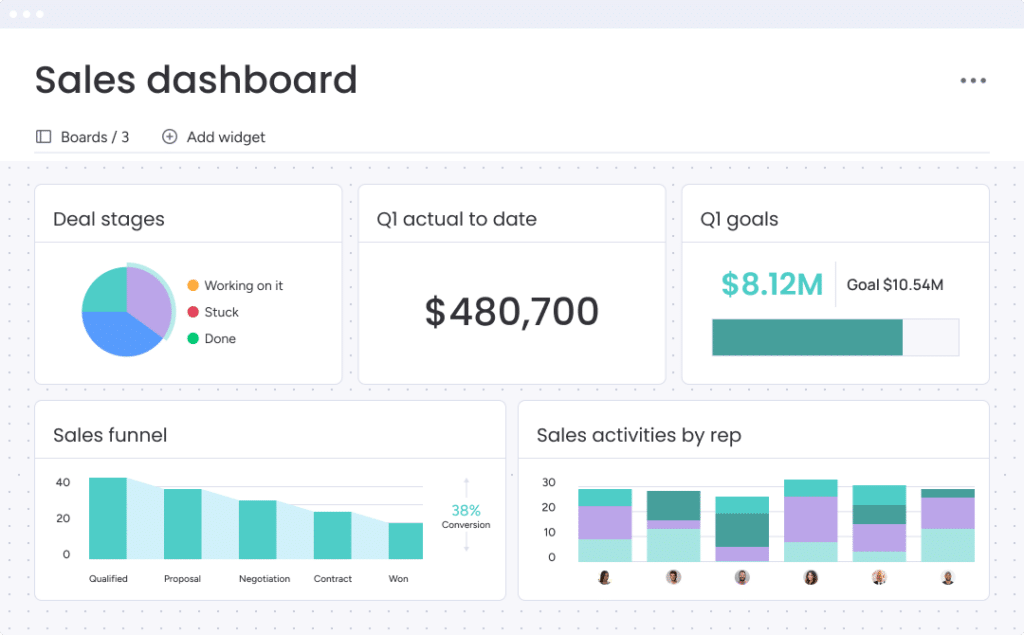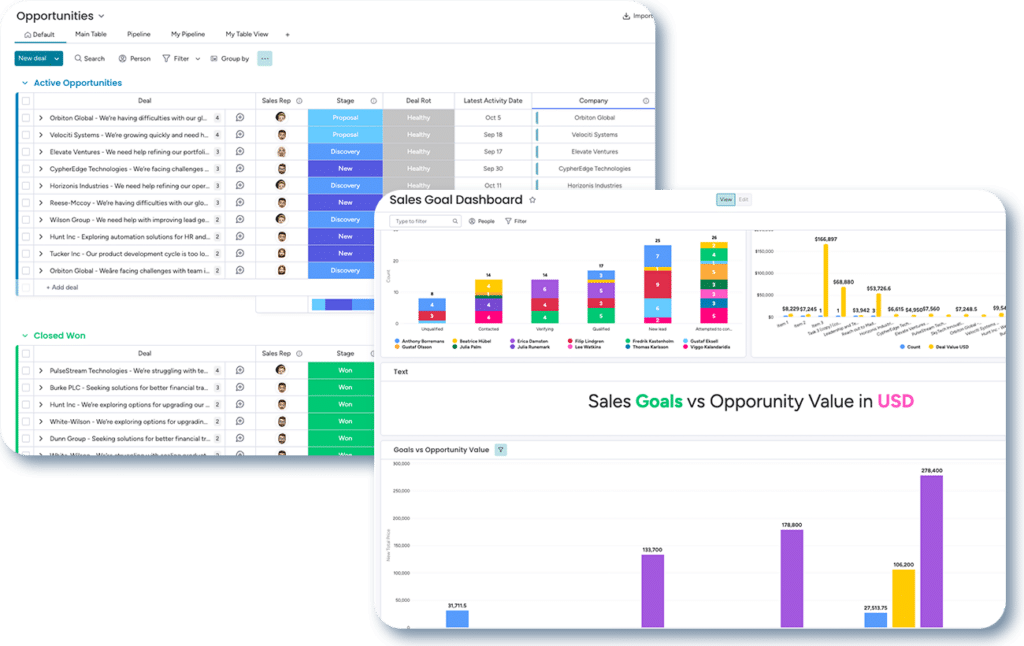Introduction
In the rapidly evolving world of business, Customer Relationship Management (CRM) systems serve as the backbone of successful sales strategies. These platforms not only help manage interactions with current and potential customers but also streamline the entire sales process. A key feature that significantly elevates the functionality of CRM systems is the visual sales pipeline. This innovative tool offers a dynamic and intuitive representation of where prospects stand in the sales process. It provides sales teams with a clear overview of their sales funnel. The incorporation of visual sales pipelines in CRM for enhanced decision-making has revolutionized how businesses approach their sales strategies. By transforming complex data into visual formats, these pipelines allow decision-makers to quickly assess performance, anticipate market trends, and make informed decisions.
This blog post explores the transformative power of visual sales pipelines in CRM for enhanced decision-making. Furthermore, detailing how they can lead to more strategic insights, better customer relationships, and ultimately, increased sales effectiveness. In this blog post, we will uncover the various benefits of integrating visual sales pipelines into CRM systems, how they help in strategizing and forecasting, and the best practices for their implementation. As businesses strive to stay competitive, understanding and utilizing visual sales pipelines in CRM for enhanced decision-making could be the key to unlocking greater efficiency and success.
Understanding Visual Sales Pipelines
Visual sales pipelines are more than just a visually appealing representation of sales data. They are also strategic tools designed to enhance understanding and drive sales efficiency. Let’s dive into what makes up these pipelines and why they are crucial for CRM effectiveness.
Definition of Visual Sales Pipelines
A visual sales pipeline is a graphical representation of the stages a prospect goes through before becoming a customer. It typically displays key stages such as lead generation, qualification, proposal, negotiation, and closure. With each being represented by distinct columns or phases. This visualization helps sales teams monitor the status of various sales opportunities at a glance, facilitating quicker and more informed decisions.
Key Components of a Visual Sales Pipeline in a CRM System
Visual sales pipelines in CRM systems consist of several critical components:
- Stages: Clearly defined steps in the sales process.
- Deals: Visual indicators of potential sales are plotted against different stages.
- Actions: Tasks or activities required to move a deal from one stage to another.
- Metrics: Performance indicators such as deal size, expected closing date, and success probability.
These components are integrated within the CRM system, providing a holistic view that supports strategic planning and real-time decision-making.
Benefits of Visualizing the Sales Pipeline
The visualization of sales pipelines within CRM systems offers numerous advantages:
- Enhanced Clarity: Visual representations help clarify the complexities of data, making it easier to comprehend the sales dynamics at play.
- Immediate Data Interpretation: Sales teams can interpret vast amounts of data quickly, identify trends, and adjust strategies without sifting through spreadsheets or reports.
- Increased Engagement: A visual pipeline keeps sales teams more engaged by providing them with a clear understanding of their targets and progress.
- Better Collaboration: It promotes transparency and enhances collaboration among team members, as everyone can see the status of the pipeline and understand their role in achieving the targets.
By leveraging visual sales pipelines in CRM for enhanced decision-making, companies can significantly improve the efficiency and outcomes of their sales processes. This integration not only simplifies the management of sales data but also empowers teams to perform at their best. As a result, this ensures that no opportunity slips through the cracks.
Omnitas Newsletter
Sign up for our monthly newsletter to stay up-to-date on our latest blog articles, videos and events!
Thank you!
You have successfully joined our subscriber list.
The Impact of Visual Sales Pipelines on Sales Strategy
The integration of visual sales pipelines into CRM systems enhances data visualization and profoundly impacts overall sales strategy. This section explores the specific ways in which visual sales pipelines facilitate more effective sales management and strategy formulation.
Enhanced Data Visibility and Accessibility
Visual sales pipelines significantly improve the visibility and accessibility of crucial sales data. With a comprehensive visual overview, sales managers and team members can easily track the progress of deals across different stages of the sales cycle. This immediate access to data allows for:
- Quick Detection of Patterns: Sales teams can quickly identify patterns and trends, such as which stages typically have longer durations or higher drop-off rates.
- Real-Time Updates: As deals progress, the visual pipeline updates in real time. This allows teams to react swiftly to changes and adapt their strategies accordingly.
This enhanced visibility not only speeds up the decision-making process but also ensures that all team members are consistently informed and aligned with the current sales status.
Improved Sales Forecasting Accuracy
One of the most significant benefits of visual sales pipelines in CRM for enhanced decision-making is the improved accuracy of sales forecasting. Visual tools help in several ways:
- Predictive Analytics: Many CRM systems equipped with visual pipelines utilize predictive analytics to forecast future sales outcomes based on historical data and current pipeline status.
- Better Risk Management: By visualizing the pipeline, teams can better assess risks at each stage, adjusting their approaches to mitigate potential losses and capitalize on emerging opportunities.
Accurate forecasting is crucial for effective resource allocation, budgeting, and strategic planning, ensuring that businesses are well-prepared for future demands.
Streamlined Sales Processes
Visual sales pipelines streamline sales processes by providing clear insights into each phase of the sales cycle. This transparency helps in:
- Identifying Bottlenecks: Teams can quickly identify stages where deals are stalled, allowing for immediate intervention to address issues.
- Enhancing Sales Cycle Efficiency: Understanding the flow of the sales cycle through visual means helps in optimizing the steps for faster conversions and better customer experiences.
Streamlined processes not only boost productivity but also enhance the overall effectiveness of the sales strategy. As a result, this contributes to higher conversion rates and customer satisfaction.

Integrating Visual Sales Pipelines with CRM Systems
The successful integration of visual sales pipelines into CRM systems is key to unlocking their full potential. This section outlines how businesses can choose the right CRM, set up visual pipelines effectively, and tailor these tools to meet their specific needs.
Choosing the Right CRM for Visual Sales Pipiles
Selecting the right CRM system that supports visual sales pipelines is critical. Here are some factors to consider:
- Customization Capabilities: Choose a CRM that allows for extensive customization to tailor visual sales pipelines according to specific business processes and needs.
- Integration Options: Ensure the CRM can seamlessly integrate with other tools and platforms used by your business. This enhances data accuracy and accessibility.
- User Interface: Opt for a CRM with an intuitive user interface. This makes it easy for sales teams to adopt and utilize visual sales pipelines.
- Scalability: Consider whether the CRM can scale with your business, supporting more complex sales pipelines and larger volumes of data as your company grows.
Popular CRM systems like monday.com are often recommended due to their robust visualization tools, ease of use, and scalability. These features make them ideal for businesses looking to implement visual sales pipelines in CRM for enhanced decision-making.
Best Practices for Setting Up a Visual Sales Pipeline in CRM
Once the right CRM is selected, setting up a visual sales pipeline effectively is the next step. Here are some best practices:
- Define Clear Stages: Clearly define each stage of your sales process and ensure these are reflected accurately in the CRM’s visual pipeline.
- Input Quality Data: The effectiveness of a visual sales pipeline depends on the quality of data entered. Ensure data accuracy and consistency across all entries.
- Regular Updates and Maintenance: Keep the CRM system and its data up to date. Regularly review and adjust the sales pipeline as needed to reflect changes in the sales strategy or market conditions.
- Train Your Team: Provide comprehensive training for your team on how to use the visual sales pipeline effectively. Ensure they understand how to interpret the data presented and how it should influence their actions.
Enhancing CRM Visual Reporting Capabilities
Beyond basic setup, enhancing the CRM’s visual reporting capabilities can provide deeper insights:
- Advanced Analytics: Utilize CRM features that offer advanced analytics to derive more nuanced insights from your visual sales pipeline.
- Custom Dashboards: Create custom dashboards that highlight key metrics important to your business’s unique needs.
- Automated Alerts: Set up automated alerts for when deals reach critical stages or if unusual patterns are detected. In turn, this ensures timely responses from your team.
Future Trends in Visual Sales Pipelines and CRM Technology
As technology evolves, so too does the landscape of CRM systems and visual sales pipelines. Staying ahead of these trends is crucial for businesses aiming to maintain competitive advantage and optimize their sales processes. Here are some key developments we expect to influence the future of visual sales pipelines.
Increased Integration with AI and Machine Learning
Artificial Intelligence (AI) and machine learning are set to play a more significant role in enhancing visual sales pipelines in CRM systems. These technologies can provide:
- Predictive Sales Analytics: AI algorithms can analyze historical data to predict future sales trends. In turn, this helps sales teams focus their efforts more effectively.
- Automated Lead Scoring: Machine learning models can score leads based on their likelihood to convert, displayed visually in the pipeline and enabling sales teams to prioritize their efforts.
- Enhanced Customer Insights: AI can help create more detailed customer profiles by analyzing behavior patterns, and enhancing the decision-making process with deeper customer insights.
More Customizable and User-Friendly Interfaces
As user experience becomes more and more of a priority, CRM systems with visual sales pipelines will likely become even more customizable and user-friendly:
- Drag-and-Drop Interfaces: Expect to see more intuitive interfaces that allow sales teams to customize their visual pipelines with simple drag-and-drop actions.
- Real-Time Customization: Systems may offer options to modify pipelines in real-time, based on immediate business needs and market conditions.
Conclusion
Throughout this exploration of visual sales pipelines in CRM for enhanced decision-making, we’ve delved into the transformative capabilities of these tools. From the basics of understanding what visual sales pipelines are to discussing advanced trends like AI integration, it’s clear that visual sales pipelines are indispensable for modern sales strategies. They not only simplify complex data but also enhance decision-making processes, leading to improved sales outcomes and business growth.
The ability to visualize sales data in real time allows businesses to stay agile, anticipate market changes, and tailor their strategies to meet evolving customer needs. As technology continues to advance, the integration of innovative tools into CRM systems will become increasingly crucial.
For those looking to harness the full potential of visual sales pipelines, choosing a robust CRM platform like monday.com is essential. The platform offers customizable visual sales pipelines that integrate seamlessly with its wide range of productivity tools. This makes it an ideal choice for businesses aiming to improve their sales processes and overall efficiency.
Ready to see how monday.com can revolutionize your sales strategy? Try monday.com for free through our exclusive link, or if you need help with implementing the platform effectively in your organization, reach out to us below. As the number one partner of monday.com in EMEA, our team at Omnitas is here to assist you with expert advice and support, ensuring you maximize your CRM investment for optimal business success.
If you found this blog post useful, make sure to sign up for our monthly newsletter below. Stay in the loop regarding all things business efficiency and automation!













